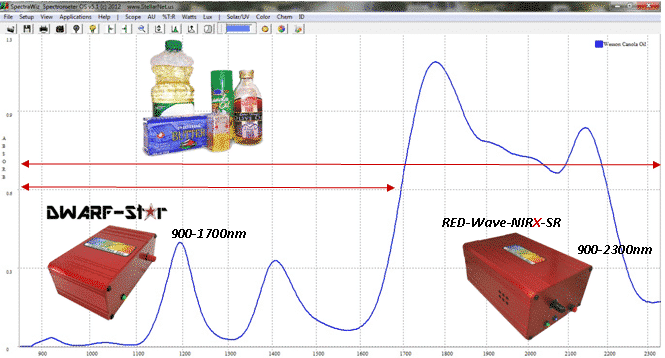Happy Thanksgiving! Every year, we like to analyze popular Thanksgiving foods by using spectroscopy. As we gather around the Thanksgiving table, the spotlight shines on the star of the feast: the perfectly roasted turkey. While the turkey is often center stage, the oils used for cooking and frying are just as essential. Quality oil choice affects not only flavor but also the safety and healthiness of the meal. StellarNet’s advanced spectroscopy products, like the StellarRAM-1064nm handheld Raman spectrometer, are well-suited for identifying mixtures of oils due to their precision and versatility.
Using Raman Spectroscopy to Analyze Oil
StellarNet’s compact Raman systems capture unique vibrational spectra that are very specific to each type of oil, distinguishing even subtle differences in composition. Raman spectroscopy with StellarNet products allows for non-invasive measurements, so oils don’t need to be prepared or altered for analysis, preserving sample integrity. This makes it particularly useful for quality control and authenticity testing of premium oils.
StellarRAM-1064nm handheld Raman for highly fluorescent samples such as sesame oil. The system’s longer wavelength, 1064nm laser, reduces background fluorescence in certain samples. Raman’s fingerprint spectrum identifies adulterants and authenticates products.
StellarNet’s spectroscopy solutions make it simple to identify and quantify oils, ensuring quality, authenticity, and purity in every analysis. Whether you’re assessing cooking oils or essential oil blends, StellarNet’s robust line of products provides the technology to meet a range of analytical needs.
So, what about using NIR spectroscopy to detect vegetable oil mixtures?
NIR spectroscopy is particularly useful in identifying and quantifying different types of oils in a mixture based on their unique molecular vibrations and absorption patterns in the NIR region.
Chemical Fingerprints: Different oils (e.g., olive, sunflower, canola) have unique profiles of fatty acids, such as saturated, monounsaturated, and polyunsaturated fats. These contribute to specific absorption bands in the NIR spectrum.
Detection of Adulteration: NIR spectroscopy can detect adulteration in high-value oils, like olive oil, by identifying the presence of less expensive oils mixed in.
Rapid and Non-Destructive Analysis: NIR provides quick and non-destructive testing, making it highly efficient for quality control in food processing.
Process: NIR spectra can be analyzed using chemometric models, which allow for the identification of specific oils and the quantification of their concentrations within a mixture. By using known standards and calibration models, NIR can accurately measure and detect even small percentages of one oil within another.
Overall, NIR spectroscopy is a reliable tool for analyzing and detecting mixtures of vegetable oils, both in quality control and food authenticity verification applications.
What’s the Best Oil to Use to Cook Turkey?
The best oil for frying a turkey is a high-smoke-point oil that can withstand the high temperatures required for deep frying (typically around 350°F or 175°C). Here are some popular options:
Peanut Oil: This is the most commonly recommended oil for frying a turkey because it has a high smoke point (about 450°F) and a neutral flavor that complements the turkey well.
Canola Oil: Another good option, canola oil has a high smoke point (around 400°F) and is more affordable than peanut oil. It’s also a good choice for those with peanut allergies.
Corn Oil: With a smoke point of about 450°F, corn oil is another suitable choice, though it may impart a slight flavor to the turkey.
Sunflower Oil: This oil also has a high smoke point (around 440°F) and a mild flavor, making it a solid alternative.
For safety, always use a thermometer to monitor the oil temperature closely, as overheating the oil can be dangerous!
Happy Thanksgiving From the StellarNet Team!

Turkey Brine Recipe

Ingredients:
- Kosher salt
- 1/4 cup sugar
- One 12- to 14-pound turkey
- 3 tablespoons whole black peppercorns
- 5 thyme branches
- 3 sage sprigs
- 1 lemon, zest peeled into strips with a vegetable peeler
Directions:
- Combine 1/2 cup salt, the sugar and 1 quart water in a medium pot and bring to a boil over high heat. Stir until the salt and sugar are fully dissolved, about 1 minute. Remove from the heat and add the peppercorns, thyme, sage and lemon strips. Let steep and cool to room temperature.
- Pour the brine into a large stockpot or bucket and add 3 quarts cold water. Remove the neck and giblets (reserve for gravy) from the turkey and put it into the brine, pushing it down to cover. Refrigerate for 24 hours.
- Remove the turkey from the brine; rinse and pat dry. Cook according to your favorite method.
Recipe courtesy of Food Network Kitchen







